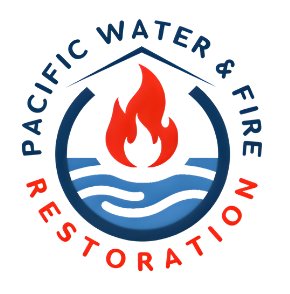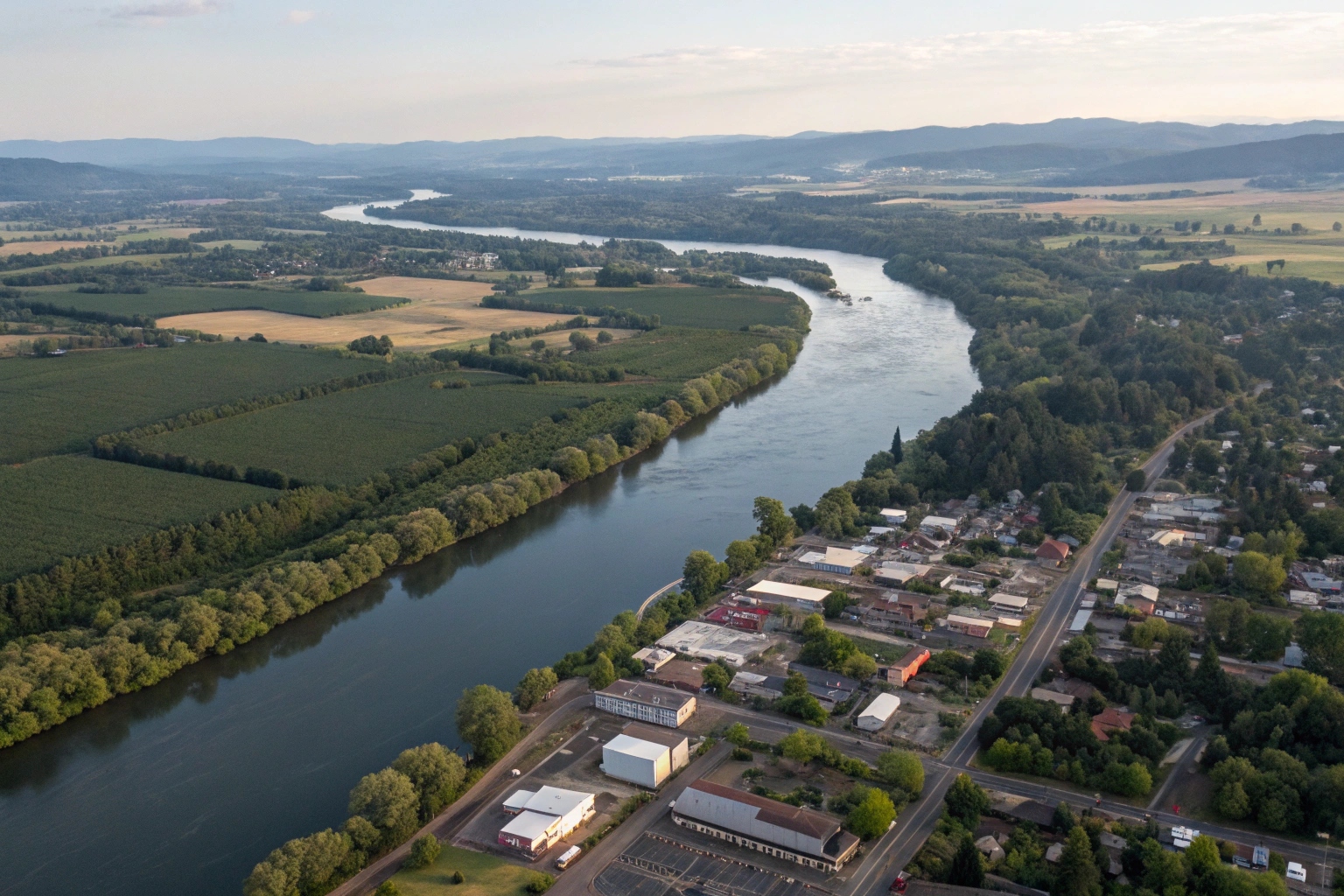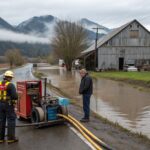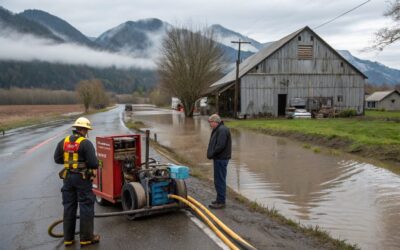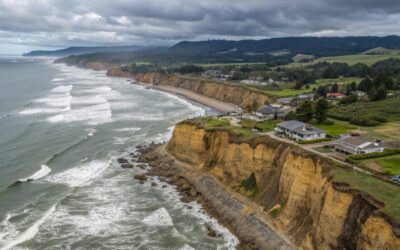Nestled in the heart of Oregon’s wine country, McMinnville enjoys a picturesque setting defined by rolling hills, fertile farmland, and the meandering Yamhill River that winds along its southern boundary. While this waterway contributes to the region’s agricultural bounty and scenic beauty, it also presents an ongoing challenge: the risk of flooding that has shaped the community’s development, infrastructure, and emergency response systems.
At Pacific Water & Fire Restoration, we’ve worked with numerous McMinnville residents and businesses to prepare for, mitigate, and recover from flooding events. This experience has given us unique insights into the city’s innovative approach to flood management and the specific challenges faced by property owners in different parts of the community.
Understanding McMinnville’s Unique Flood Profile
McMinnville’s flood vulnerability stems from several geographic and development factors that create a distinctive risk landscape.
Watershed Characteristics
The South Yamhill River watershed encompasses approximately 930 square miles, with water traveling through diverse terrain before reaching McMinnville:
- Coast Range Headwaters: The river begins in the Coast Range mountains, where steep terrain can accelerate water flow during heavy rainfall
- Agricultural Influence: Much of the watershed consists of agricultural land, which can contribute to runoff patterns during winter storms
- Tributary Systems: Cozine Creek and other smaller waterways flow through McMinnville before joining the Yamhill River, creating additional flood pathways
- Seasonal Patterns: The Yamhill River typically experiences highest flows between November and February, with historical crests predominantly occurring in these months
Development Patterns
McMinnville’s growth history has shaped its flood vulnerability:
- Historic Downtown: Parts of McMinnville’s historic downtown district were developed before modern flood management practices, creating vulnerability in some older commercial buildings
- Residential Expansion: Newer neighborhoods like Michelbook and neighborhoods west of Hill Road have incorporated more advanced stormwater management
- Agricultural Transition Zones: Areas transitioning from agricultural to residential use present unique drainage challenges
- Infrastructure Evolution: The city’s stormwater infrastructure ranges from century-old systems downtown to state-of-the-art facilities in newer developments
Historical Context
McMinnville has experienced several significant flooding events that have informed current practices:
- The December 1964 Christmas Flood, which caused widespread damage throughout the Willamette Valley
- February 1996 flooding that affected parts of downtown and southern neighborhoods
- December 2007 flooding during an atmospheric river event
- January 2012 high water events along the Yamhill River
According to data from the National Weather Service, major flood stage for the South Yamhill River at McMinnville is 55 feet, with moderate flooding beginning at 52 feet. Historical crests have reached as high as 57.9 feet (December 1964), demonstrating the potential for significant impacts.
Pro Tip: McMinnville residents can monitor current river levels and forecasts through the National Weather Service’s Advanced Hydrologic Prediction Service online. This free resource provides real-time data and projected river stages for the South Yamhill River at McMinnville.
McMinnville’s Multi-Faceted Flood Management Approach
McMinnville has developed one of the Willamette Valley’s most comprehensive approaches to flood management, combining infrastructure, planning, and community engagement.
Infrastructure Investments
The city has made significant investments in flood mitigation infrastructure:
Stormwater System Upgrades
- Separated Systems: Ongoing work to separate stormwater and sewer systems, reducing overflow risks during heavy rainfall
- Detention Facilities: Multiple stormwater detention basins throughout the city, with notable facilities near Michelbook Golf Course and in the Northeast Heights area
- Green Infrastructure: Integration of rain gardens, bioswales, and permeable surfaces in newer developments and retrofitted areas
- Pump Stations: Strategic placement of pump stations to manage water in low-lying areas
- Culvert Improvements: Ongoing program to upgrade and enlarge culverts at critical junctures
Natural Systems Enhancement
McMinnville has recognized the value of natural flood mitigation:
- Floodplain Preservation: Protection of natural floodplain areas along the Yamhill River to absorb high water
- Riparian Restoration: Efforts to restore native vegetation along Cozine Creek and other waterways
- Wetland Conservation: Preservation of wetland areas that provide natural water storage
- Agricultural Partnerships: Collaboration with surrounding farms on water management during heavy rainfall
Planning and Zoning Adaptations
The city has incorporated flood resilience into its long-term planning:
- Floodplain Development Restrictions: Limitations on new construction in mapped floodplains
- Elevation Requirements: Higher foundation requirements for structures in flood-prone areas
- Stormwater Management Standards: Progressive standards for new development that exceed state requirements
- Freeboard Requirements: Building codes requiring additional height above base flood elevation
- Critical Infrastructure Placement: Strategic location of new critical facilities outside flood-prone areas
Early Warning Systems
McMinnville has implemented comprehensive early warning capabilities:
- River Gauge Network: Real-time monitoring stations along the Yamhill River and tributaries
- Weather Monitoring: Local weather stations providing precipitation data
- Yamhill County Alerts: Opt-in emergency notification system delivering location-specific warnings
- Social Media Integration: Use of city social channels for emergency communications
- Multilingual Alerts: Emergency information available in Spanish to serve McMinnville’s diverse population
Property-Level Flood Prevention for McMinnville Residents
While community-wide approaches provide substantial protection, individual property measures remain essential, particularly in higher-risk areas.
Know Your Flood Risk
Understanding your specific property’s vulnerability is the essential first step:
- FEMA Flood Maps: Determine if your property is within a designated Special Flood Hazard Area (primarily along the Yamhill River and Cozine Creek)
- Localized Flooding: Some areas of McMinnville experience localized flooding due to stormwater issues rather than river overflow
- Historical Patterns: Consult with neighbors and long-time residents about historical flooding in your specific neighborhood
- Elevation Assessment: Professional evaluation of your property’s elevation relative to potential flood levels
According to Yamhill County Emergency Management, specific McMinnville neighborhoods with heightened awareness needs include:
- Old Sheridan Road area
- Parts of West 2nd Street and surrounding neighborhoods
- Areas along Cozine Creek through central McMinnville
- Sections of the historic downtown during extraordinary events
Structural Flood Prevention Measures
Drainage Improvements
Proper drainage is crucial for McMinnville properties due to the clay-rich soils and substantial winter rainfall:
- Proper Grading: Ensure your yard slopes away from the foundation at a minimum 6-inch drop over 10 feet
- Gutter Systems: Maintain clean gutters and extend downspouts at least 10 feet from foundations
- French Drains: Consider installing French drains in areas prone to standing water
- Sump Pump Systems: Install sump pumps with battery backups in basements or crawlspaces
- Backflow Prevention: Install backflow preventers on sewer lines to prevent sewage backup during floods
Property Modifications
For properties with identified flood risk:
- Elevation of Utilities: Raise electrical panels, water heaters, and HVAC equipment above potential flood levels
- Basement Considerations: Avoid storing valuable items in basements, particularly in downtown buildings
- Flood-Resistant Materials: When renovating, use flood-resistant materials for lower portions of the structure
- Sealing and Waterproofing: Apply appropriate waterproofing to foundation walls
- Deployable Barriers: Consider temporary flood barriers for doorways and garages in high-risk areas
Safety Warning: Never store hazardous materials like pesticides, paint, or chemicals in areas that could flood. During the 1996 Willamette Valley floods, chemical contamination from flooded storage areas created additional hazards and complicated cleanup efforts throughout the region.
McMinnville’s Community-Based Flood Response
One of McMinnville’s most innovative approaches has been its development of neighborhood-level flood response networks.
Neighborhood Response Teams
Several McMinnville neighborhoods have established formal response structures:
- Team Organization: Designated coordinators for specific geographic areas
- Skills Inventory: Documentation of residents with relevant skills (medical, construction, communication)
- Equipment Sharing: Shared access to pumps, generators, and flood barriers
- Vulnerable Resident Identification: Programs to ensure elderly and disabled residents receive assistance
- Communication Plans: Established phone trees and meeting locations if normal communications fail
Business Continuity Networks
Downtown McMinnville businesses have developed collaborative flood preparation:
- Mutual Aid Agreements: Formal arrangements for sharing resources and assistance
- Shared Storage Solutions: Elevated storage options for inventory during flood threats
- Flood-Specific Business Plans: Templates and training for business continuity
- Early Warning Protocols: Systems to alert businesses of potential flooding with enough lead time to implement protection measures
- Recovery Partnerships: Pre-arranged services for rapid restoration after flooding
Agricultural Coordination
The farming community surrounding McMinnville has developed cooperative approaches:
- Equipment Sharing: Pooled resources for water pumping and management
- Livestock Evacuation Plans: Coordinated systems for moving livestock during flood threats
- Crop Protection Strategies: Collaborative approaches to mitigating crop damage
- Drainage Coordination: Managed approaches to field drainage that consider downstream impacts
Case Study: Downtown McMinnville’s Business District Approach
Following the 2007 high water events, downtown McMinnville’s business district implemented an innovative flood preparedness program that has become a model for other commercial areas in the Willamette Valley:
- Vulnerability Assessment: Professional evaluation of each building’s specific flood vulnerabilities, resulting in customized protection plans.
- Shared Resources: The Downtown Association established a shared equipment cache including pumps, generators, flood barriers, and cleaning supplies, available to all member businesses.
- Early Detection System: Installation of water sensors in basements and low-lying areas connected to an alert system providing early warning of rising water.
- Rapid Response Teams: Designated teams with specific responsibilities during flood threats, including deployment of barriers and assistance to highest-risk businesses.
- Recovery Partnership: Pre-arranged agreements with restoration companies (including Pacific Water & Fire Restoration) to provide priority response during area-wide events.
This coordinated approach was tested during high water events in 2012 and significantly reduced business disruption compared to previous floods.
Emergency Response: When Waters Rise
Despite the best preventative efforts, flooding can still occur, especially during exceptional weather events. Knowing how to respond can save lives and protect property.
Evacuation Preparation
McMinnville residents, particularly those in identified risk areas, should prepare for potential evacuation:
- Go Bag Essentials:
- Important documents (insurance policies, identification, medical records)
- Medications and prescriptions
- Cell phone chargers and battery backups
- Change of clothes and personal hygiene items
- Basic first aid supplies
- Pet essentials if applicable
- Evacuation Routes:
- Know primary and alternate evacuation routes from your neighborhood
- Have paper maps available (don’t rely solely on digital navigation)
- Identify multiple destinations where you could temporarily relocate
- Plan for family reunification if separated
- Home Preparation Before Leaving:
- Move valuable items to higher levels
- Shut off utilities if instructed by authorities
- Lock doors and windows
- Take final documentation photos
- Follow official evacuation routes, avoiding flooded roads
Property Protection During Flooding
If evacuation is not necessary or imminent, take these steps to protect your property:
- Electricity Safety: Turn off electricity at the main breaker if water threatens electrical systems
- Barrier Deployment: Place sandbags or temporary flood barriers at entry points if available
- Valuable Relocation: Move important items to the highest level of your home
- Water Flow Management: Clear drains and gutters to ensure proper water flow away from the structure
- Documentation: Take photos and videos of conditions and protection measures
After the Flood: Recovery Steps
When waters recede, a systematic approach to recovery improves outcomes:
- Safety First:
- Return to your property only when authorities declare it safe
- Watch for structural damage, electrical hazards, and contamination
- Wear appropriate protective gear including gloves, boots, and masks
- Be aware of wildlife that may have been displaced by flooding
- Documentation:
- Photograph and video all damage before beginning cleanup
- Record all damaged items and structures
- Keep receipts for all emergency expenses
- Contact your insurance company immediately
- Initial Cleanup:
- Remove standing water if safe to do so
- Begin removing wet materials that cannot be salvaged
- Increase airflow with fans if electricity is safely restored
- Clean and disinfect everything that got wet
The Professional Restoration Process
At Pacific Water & Fire Restoration, our approach to flood recovery in McMinnville addresses the specific challenges of the region’s flood characteristics.
Comprehensive Damage Assessment
Our first step involves a thorough evaluation of both obvious and hidden damage:
- Moisture Mapping: Using thermal imaging and moisture meters to identify water intrusion not visible to the naked eye
- Structural Evaluation: Assessing impact on foundation, framing, and other structural elements
- Contents Assessment: Evaluating damaged belongings for restoration potential
- Contamination Evaluation: Testing for microbial growth and chemical contaminants based on flood source
Water Removal and Drying
Our systematic drying process follows industry best practices:
- Water Extraction: Using commercial-grade pumps and extraction units specifically selected for the type of flooding
- Strategic Drying Plan: Developing a customized drying plan based on building materials, extent of saturation, and weather conditions
- Dehumidification: Deploying industrial dehumidifiers sized appropriately for the space
- Air Movement: Strategically placing air movers to create optimal evaporation conditions
- Daily Monitoring: Tracking moisture levels and adjusting equipment as needed
- Hidden Space Drying: Addressing water in wall cavities, under flooring, and other concealed spaces
Sanitization and Mold Prevention
McMinnville’s climate creates significant risk for mold growth after flooding:
- Antimicrobial Application: Treating affected areas with appropriate sanitizing agents
- Containment Procedures: Establishing containment zones during cleanup to prevent cross-contamination
- Air Filtration: Using HEPA filtration to remove airborne contaminants
- Material Removal: Eliminating materials that cannot be effectively sanitized
- Preventive Treatments: Applying mold-preventive solutions to at-risk materials
Reconstruction and Mitigation
Our restoration process incorporates future flood resistance:
- Flood-Resistant Materials: Recommending appropriate materials for reconstruction
- Structural Improvements: Incorporating mitigation measures during rebuilding
- Drainage Enhancements: Addressing identified drainage issues
- Utility Relocation: Moving vulnerable systems to higher locations when possible
- Documentation: Providing complete documentation for insurance and future reference
Pro Tip: Save samples of damaged materials, especially unique or custom items like trim, flooring, and wallcoverings. These samples can be invaluable for matching during reconstruction and for insurance documentation.
Insurance Considerations for McMinnville Property Owners
Understanding flood insurance options is particularly important for McMinnville residents:
Flood Insurance Basics
- Standard homeowners and business insurance policies typically do not cover flood damage
- National Flood Insurance Program (NFIP) policies are available to all McMinnville residents, regardless of flood zone
- Properties in Special Flood Hazard Areas with federally-backed mortgages are required to have flood insurance
- There is typically a 30-day waiting period before new flood insurance policies take effect
- Even properties outside designated flood zones should consider coverage due to McMinnville’s creek systems and stormwater considerations
Coverage Considerations
When evaluating flood insurance for McMinnville properties, consider:
- Building vs. Contents Coverage: NFIP policies separate coverage for the structure and personal belongings
- Replacement Cost vs. Actual Cash Value: Building coverage typically pays replacement cost, while contents coverage usually pays actual cash value
- Coverage Limits: NFIP policies have coverage limits that may be insufficient for higher-value properties
- Excess Flood Insurance: Consider supplemental private market coverage above NFIP limits
- Business Considerations: Business owners should evaluate both property damage and business interruption coverage
According to FEMA, the average flood insurance claim payment in Oregon is approximately $20,000, while the average annual premium in moderate to low-risk areas ranges from $400-$600.
Climate Change Implications for McMinnville
Climate projections suggest several changes that could affect McMinnville’s flood risk profile:
- Increased Precipitation Intensity: Climate models predict more frequent heavy rainfall events in the Pacific Northwest
- Seasonal Shifts: More precipitation falling as rain rather than snow in the Coast Range during winter
- Atmospheric River Events: Potential increase in atmospheric river events that bring sustained heavy rainfall
- Longer Dry Periods: More pronounced dry seasons may affect soil absorption capacity when rains return
According to Oregon Climate Change Research Institute, the Willamette Valley could see a 10-15% increase in winter precipitation by mid-century, with more of this falling during intense weather events rather than as steady rainfall.
Conclusion: Building a Flood-Resilient McMinnville
McMinnville’s approach to flood management demonstrates how combining innovative infrastructure, thoughtful planning, and strong community engagement creates resilience even in flood-prone regions. The city’s multi-faceted strategy has transformed potential vulnerability into a model of preparedness that other communities throughout the Willamette Valley are beginning to emulate.
At Pacific Water & Fire Restoration, we’re committed to helping McMinnville property owners navigate the challenges of living in a riverside community—both in preventing flood damage through proper preparation and providing expert restoration services when needed.
Take Action Today
Don’t wait until the forecast calls for heavy rain to address potential flood vulnerabilities:
- Emergency Response: For immediate flood damage, call our 24/7 emergency line at 503-201-7337
- Preventative Assessment: Schedule a free property evaluation to identify potential vulnerabilities and develop mitigation strategies
- Restoration Consultation: If you’ve experienced flooding in the past, our specialists can help identify and address underlying issues to prevent future damage
Remember, in McMinnville’s unique environment along the Yamhill River, flood preparedness isn’t just about protecting your property—it’s about preserving the riverside community character that makes this area special.
Pacific Water & Fire Restoration serves the entire Portland metro area, including McMinnville, Newberg, Dundee, and surrounding communities. Our IICRC-certified professionals are available 24/7 for emergency response to water, fire, mold, and storm damage. Contact us at 503-201-7337 or visit our website to learn more about our comprehensive restoration services.
